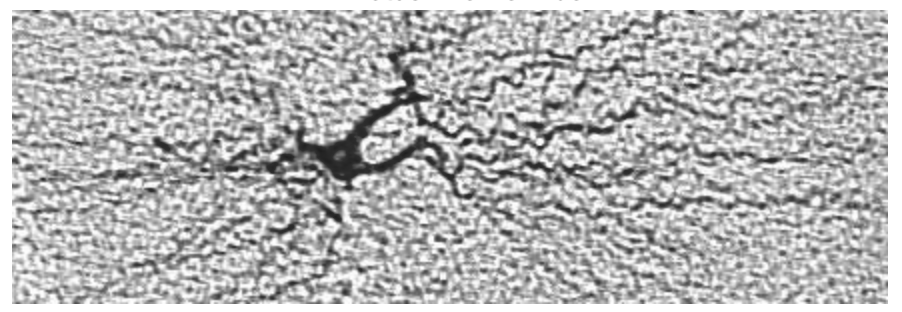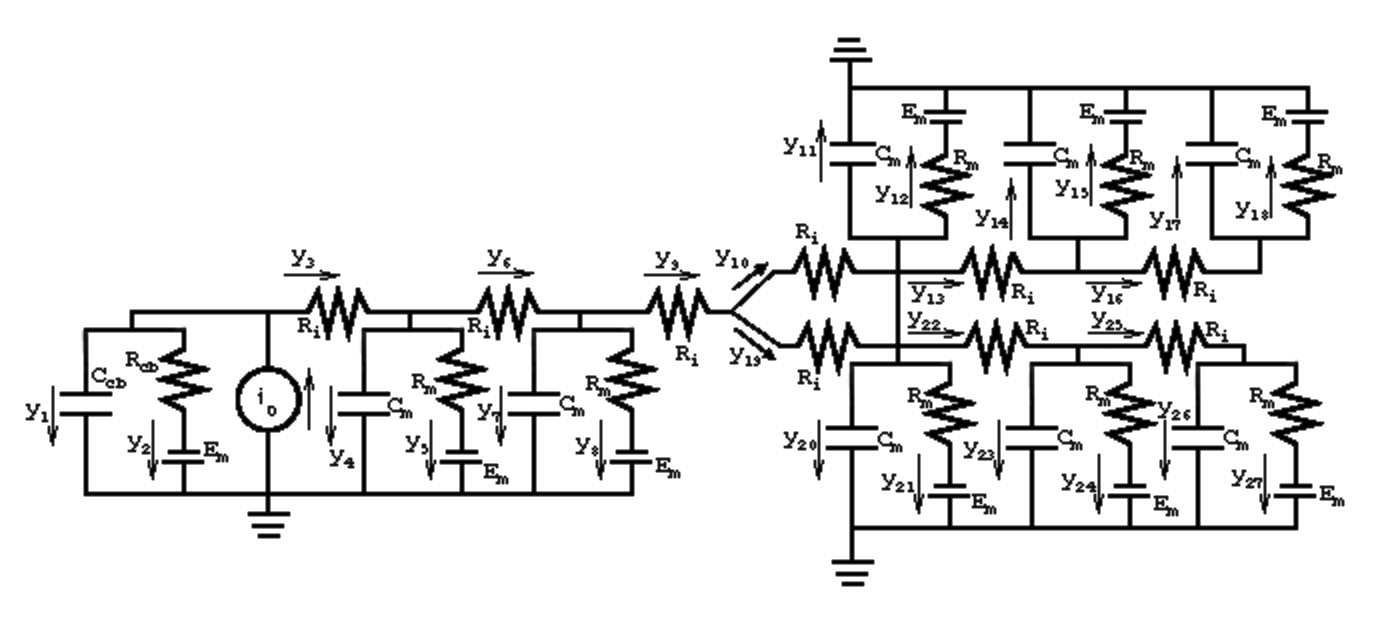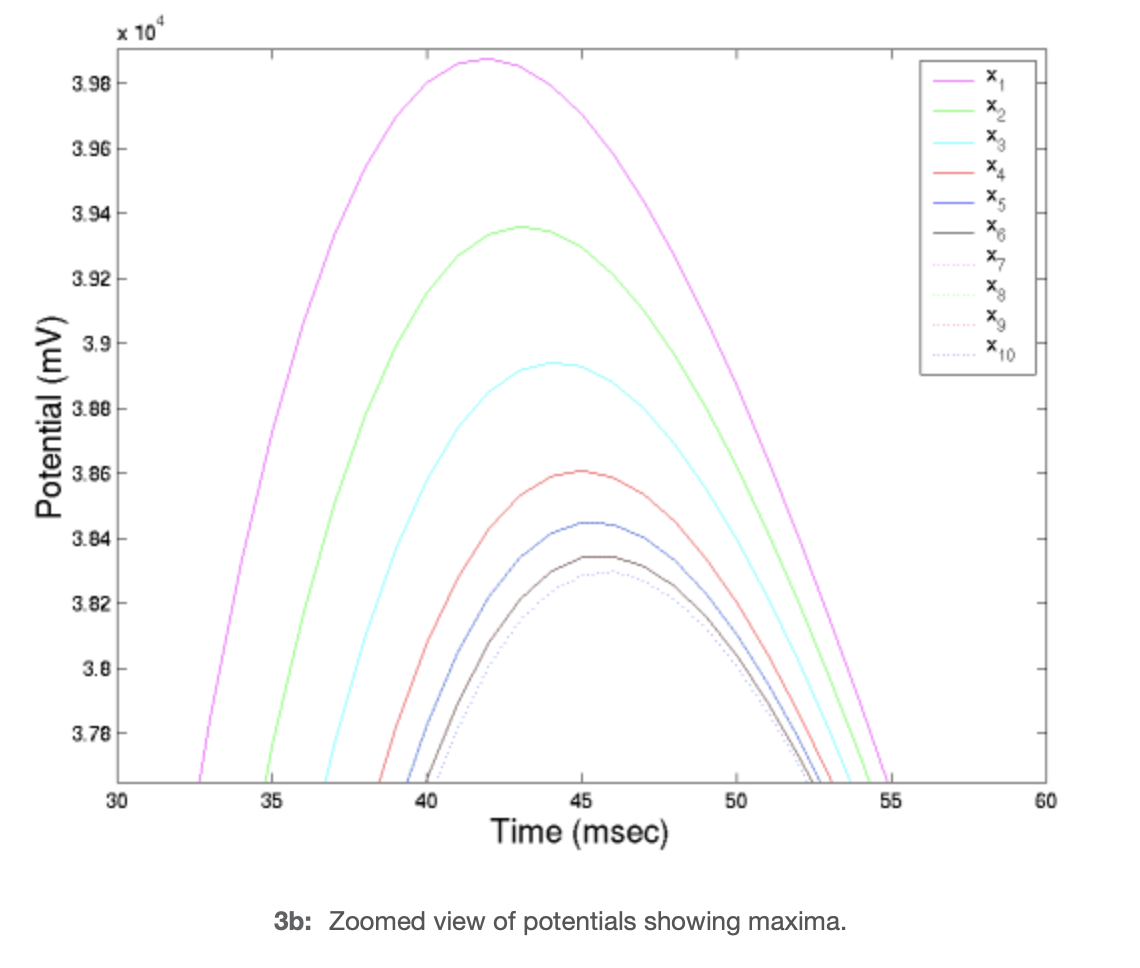5.6: Supplemental - Matrix Analysis of the Branched Dendrite Nerve Fiber
( \newcommand{\kernel}{\mathrm{null}\,}\)
Introduction
In the prior modules on static and dynamic electrical systems, we analyzed basic, hypothetical one-branch nerve fibers using a modeling methodology we dubbed the Strang Quartet. You may be asking yourself whether this method is stout enough to handle the real fiber of our minds. Indeed, can we use our tools in a real-world setting (Figure \PageIndex{1})?

To answer your question, the above is a rendering of a neuron from a rat's hippocampus. The tools we have refined will enable us to model the electrical properties of a dendrite leaving the neuron's cell body. A three-branch model of such a dendrite, traced out with painstaking accuracy, appears in Figure \PageIndex{2}.

Our multi-compartment model reveals a 3 branch, 10 node, 27 edge structure to the fiber. Note that we have included the Nernst potentials, the nervous impulse as a current source, and the additional leftmost edges depicting stimulus current shunted by the cell body.
We will continue using our previous notation, namely: R_{i} and R_{m} denoting cell body. and membrane resistances, respectively; \textbf{x} representing the vector of potentials x_{1} \cdots x_{10}, and \textbf{x} denoting the vector of currents y_{1} \cdots y_{27}. Using the typical value for a cell's membrane
c = 1(μF/cm^{2}) \nonumber
we derive (see variable conventions):
C_{m} = 2 \pi a\frac{l}{N}c \nonumber
This capacitance is modeled in parallel with the cell's membrane resistance. Additionally, letting A_{cb} denote the cell body's surface area, we recall that its capacitance and resistance are
C_{cb} = A_{cb} c \nonumber
C_{cb} = A_{cb} \rho_{m} \nonumber
Applying the Strang Quartet
Step (S1')--Voltage Drops
Let's begin filling out the Strang Quartet. For Step (S1'), we first observe the voltage drops in the figure. Since there are a whopping 27 of them, we include only the first six, which are slightly more than we need to cover all variations in the set:
e_{1} = x_{1} \nonumber
e_{2} = x_{1}-E_{m} \nonumber
e_{3} = x_{1}-x_{2} \nonumber
e_{4} = x_{2} \nonumber
e_{5} = x_{2}-E_{m} \nonumber
e_{6} = x_{2}-x_{3} \nonumber
\cdots \nonumber
e_{27} = x_{10}-E_{m} \nonumber
In matrix for, letting \textbf{b} denote the vector of batteries,
\begin{array}{ccc} {\textbf{x} = \textbf{b}-A \textbf{x}}&{where}&{\textbf{b} = (-Em) \begin{pmatrix} {0}\\{1}\\{0}\\{0}\\{1}\\{0}\\{0}\\{1}\\{0}\\{0}\\{0}\\{1}\\{0}\\{0}\\{1}\\{0}\\{0}\\{1}\\{0}\\{0}\\{1}\\{0}\\{0}\\{1}\\{0}\\{0}\\{1} \end{pmatrix}} \end{array} \nonumber
and
A = \begin{pmatrix} {-1}&{0}&{0}&{0}&{0}&{0}&{0}&{0}&{0}&{0}\\ {-1}&{0}&{0}&{0}&{0}&{0}&{0}&{0}&{0}&{0}\\ {-1}&{1}&{0}&{0}&{0}&{0}&{0}&{0}&{0}&{0}\\{0}&{-1}&{0}&{0}&{0}&{0}&{0}&{0}&{0}&{0}\\ {0}&{-1}&{0}&{0}&{0}&{0}&{0}&{0}&{0}&{0}\\ {0}&{-1}&{1}&{0}&{0}&{0}&{0}&{0}&{0}&{0}\\ {0}&{0}&{-1}&{0}&{0}&{0}&{0}&{0}&{0}&{0}\\ {0}&{0}&{-1}&{0}&{0}&{0}&{0}&{0}&{0}&{0}\\ {0}&{0}&{-1}&{1}&{0}&{0}&{0}&{0}&{0}&{0}\\ {0}&{0}&{0}&{1}&{-1}&{0}&{0}&{0}&{0}&{0}\\ {0}&{0}&{0}&{0}&{-1}&{0}&{0}&{0}&{0}&{0}\\ {0}&{0}&{0}&{0}&{-1}&{0}&{0}&{0}&{0}&{0}\\ {0}&{0}&{0}&{0}&{-1}&{1}&{0}&{0}&{0}&{0}\\ {0}&{0}&{0}&{0}&{0}&{-1}&{0}&{0}&{0}&{0}\\ {0}&{0}&{0}&{0}&{0}&{-1}&{0}&{0}&{0}&{0}\\ {0}&{0}&{0}&{0}&{0}&{-1}&{1}&{0}&{0}&{0}\\ {0}&{0}&{0}&{0}&{0}&{0}&{-1}&{0}&{0}&{0}\\ {0}&{0}&{0}&{0}&{0}&{0}&{-1}&{0}&{0}&{0}\\ {0}&{0}&{0}&{-1}&{0}&{0}&{0}&{1}&{0}&{0}\\ {0}&{0}&{0}&{0}&{0}&{0}&{0}&{-1}&{0}&{0}\\ {0}&{0}&{0}&{0}&{0}&{0}&{0}&{-1}&{0}&{0}\\ {0}&{0}&{0}&{0}&{0}&{0}&{0}&{-1}&{1}&{0}\\ {0}&{0}&{0}&{0}&{0}&{0}&{0}&{0}&{-1}&{0}\\ {0}&{0}&{0}&{0}&{0}&{0}&{0}&{0}&{-1}&{0}\\ {0}&{0}&{0}&{0}&{0}&{0}&{0}&{0}&{-1}&{1}\\ {0}&{0}&{0}&{0}&{0}&{0}&{0}&{0}&{0}&{-1}\\ {0}&{0}&{0}&{0}&{0}&{0}&{0}&{0}&{0}&{-1}\\ \end{pmatrix} \nonumber
Although our adjacency matrix A is appreciably larger than our previous examples, we have captured the same phenomena as before.
Applying (S2): Ohm's Law Augmented with Voltage-Current Law for Capacitors
Now, recalling Ohm's Law and remembering that the current through a capacitor varies proportionately with the time rate of change of the potential across it, we assemble our vector of currents. As before, we list only enough of the 27 currents to fully characterize the set:
y_{1} = C_{cb} \frac{de_{1}}{dt} \nonumber
y_{2} = \frac{e_{2}}{R_{cb}} \nonumber
y_{3} = \frac{e_{3}}{R_{i}} \nonumber
y_{4} = C_{m} \frac{de_{4}}{dt} \nonumber
y_{5} = \frac{e_{5}}{R_{m}} \nonumber
\cdots \nonumber
y_{27} = \frac{e_{27}}{R_{m}} \nonumber
In matrix terms, this compiles to
\textbf{y} = G \textbf{e}+Cd \textbf{e} dt \nonumber
where
Conductance matrix
G = \begin{pmatrix} {0}&{0}&{0}&{0}&{0}&{0}&{0}&{0}&{0}&{0}&{0}&{0}&{0}&{0}&{0}&{0}&{0}&{0}&{0}&{0}&{0}&{0}&{0}&{0}&{0}&{0}&{0}\\ {0}&{\frac{1}{R_{cb}}}&{0}&{0}&{0}&{0}&{0}&{0}&{0}&{0}&{0}&{0}&{0}&{0}&{0}&{0}&{0}&{0}&{0}&{0}&{0}&{0}&{0}&{0}&{0}&{0}&{0}\\ {0}&{0}&{\frac{1}{R_{i}}}&{0}&{0}&{0}&{0}&{0}&{0}&{0}&{0}&{0}&{0}&{0}&{0}&{0}&{0}&{0}&{0}&{0}&{0}&{0}&{0}&{0}&{0}&{0}&{0}\\ {0}&{0}&{0}&{0}&{0}&{0}&{0}&{0}&{0}&{0}&{0}&{0}&{0}&{0}&{0}&{0}&{0}&{0}&{0}&{0}&{0}&{0}&{0}&{0}&{0}&{0}&{0}\\ {0}&{0}&{0}&{0}&{\frac{1}{R_{m}}}&{0}&{0}&{0}&{0}&{0}&{0}&{0}&{0}&{0}&{0}&{0}&{0}&{0}&{0}&{0}&{0}&{0}&{0}&{0}&{0}&{0}&{0}\\ {0}&{0}&{0}&{0}&{0}&{\frac{1}{R_{i}}}&{0}&{0}&{0}&{0}&{0}&{0}&{0}&{0}&{0}&{0}&{0}&{0}&{0}&{0}&{0}&{0}&{0}&{0}&{0}&{0}&{0}\\ {0}&{0}&{0}&{0}&{0}&{0}&{0}&{0}&{0}&{0}&{0}&{0}&{0}&{0}&{0}&{0}&{0}&{0}&{0}&{0}&{0}&{0}&{0}&{0}&{0}&{0}&{0}\\ {0}&{0}&{0}&{0}&{0}&{0}&{0}&{\frac{1}{R_{i}}}&{0}&{0}&{0}&{0}&{0}&{0}&{0}&{0}&{0}&{0}&{0}&{0}&{0}&{0}&{0}&{0}&{0}&{0}&{0}\\ {0}&{0}&{0}&{0}&{0}&{0}&{0}&{0}&{\frac{1}{R_{i}}}&{0}&{0}&{0}&{0}&{0}&{0}&{0}&{0}&{0}&{0}&{0}&{0}&{0}&{0}&{0}&{0}&{0}&{0}\\ {0}&{0}&{0}&{0}&{0}&{0}&{0}&{0}&{0}&{\frac{1}{R_{i}}}&{0}&{0}&{0}&{0}&{0}&{0}&{0}&{0}&{0}&{0}&{0}&{0}&{0}&{0}&{0}&{0}&{0}\\ {0}&{0}&{0}&{0}&{0}&{0}&{0}&{0}&{0}&{0}&{0}&{0}&{0}&{0}&{0}&{0}&{0}&{0}&{0}&{0}&{0}&{0}&{0}&{0}&{0}&{0}&{0}\\ {0}&{0}&{0}&{0}&{0}&{0}&{0}&{0}&{0}&{0}&{0}&{\frac{1}{R_{m}}}&{0}&{0}&{0}&{0}&{0}&{0}&{0}&{0}&{0}&{0}&{0}&{0}&{0}&{0}&{0}\\ {0}&{0}&{0}&{0}&{0}&{0}&{0}&{0}&{0}&{0}&{0}&{0}&{\frac{1}{R_{i}}}&{0}&{0}&{0}&{0}&{0}&{0}&{0}&{0}&{0}&{0}&{0}&{0}&{0}&{0}\\ {0}&{0}&{0}&{0}&{0}&{0}&{0}&{0}&{0}&{0}&{0}&{0}&{0}&{0}&{0}&{0}&{0}&{0}&{0}&{0}&{0}&{0}&{0}&{0}&{0}&{0}&{0}\\ {0}&{0}&{0}&{0}&{0}&{0}&{0}&{0}&{0}&{0}&{0}&{0}&{0}&{0}&{\frac{1}{R_{m}}}&{0}&{0}&{0}&{0}&{0}&{0}&{0}&{0}&{0}&{0}&{0}&{0}\\ {0}&{0}&{0}&{0}&{0}&{0}&{0}&{0}&{0}&{0}&{0}&{0}&{0}&{0}&{0}&{\frac{1}{R_{i}}}&{0}&{0}&{0}&{0}&{0}&{0}&{0}&{0}&{0}&{0}&{0}\\ {0}&{0}&{0}&{0}&{0}&{0}&{0}&{0}&{0}&{0}&{0}&{0}&{0}&{0}&{0}&{0}&{0}&{0}&{0}&{0}&{0}&{0}&{0}&{0}&{0}&{0}&{0}\\ {0}&{0}&{0}&{0}&{0}&{0}&{0}&{0}&{0}&{0}&{0}&{0}&{0}&{0}&{0}&{0}&{0}&{\frac{1}{R_{m}}}&{0}&{0}&{0}&{0}&{0}&{0}&{0}&{0}&{0}\\ {0}&{0}&{0}&{0}&{0}&{0}&{0}&{0}&{0}&{0}&{0}&{0}&{0}&{0}&{0}&{0}&{0}&{0}&{\frac{1}{R_{i}}}&{0}&{0}&{0}&{0}&{0}&{0}&{0}&{0}\\ {0}&{0}&{0}&{0}&{0}&{0}&{0}&{0}&{0}&{0}&{0}&{0}&{0}&{0}&{0}&{0}&{0}&{0}&{0}&{0}&{0}&{0}&{0}&{0}&{0}&{0}&{0}\\ {0}&{0}&{0}&{0}&{0}&{0}&{0}&{0}&{0}&{0}&{0}&{0}&{0}&{0}&{0}&{0}&{0}&{0}&{0}&{0}&{\frac{1}{R_{m}}}&{0}&{0}&{0}&{0}&{0}&{0}\\ {0}&{0}&{0}&{0}&{0}&{0}&{0}&{0}&{0}&{0}&{0}&{0}&{0}&{0}&{0}&{0}&{0}&{0}&{0}&{0}&{0}&{\frac{1}{R_{i}}}&{0}&{0}&{0}&{0}&{0}\\ {0}&{0}&{0}&{0}&{0}&{0}&{0}&{0}&{0}&{0}&{0}&{0}&{0}&{0}&{0}&{0}&{0}&{0}&{0}&{0}&{0}&{0}&{0}&{0}&{0}&{0}&{0}\\ {0}&{0}&{0}&{0}&{0}&{0}&{0}&{0}&{0}&{0}&{0}&{0}&{0}&{0}&{0}&{0}&{0}&{0}&{0}&{0}&{0}&{0}&{0}&{\frac{1}{R_{m}}}&{0}&{0}&{0}\\ {0}&{0}&{0}&{0}&{0}&{0}&{0}&{0}&{0}&{0}&{0}&{0}&{0}&{0}&{0}&{0}&{0}&{0}&{0}&{0}&{0}&{0}&{0}&{0}&{\frac{1}{R_{i}}}&{0}&{0}\\ {0}&{0}&{0}&{0}&{0}&{0}&{0}&{0}&{0}&{0}&{0}&{0}&{0}&{0}&{0}&{0}&{0}&{0}&{0}&{0}&{0}&{0}&{0}&{0}&{0}&{0}&{0}\\ {0}&{0}&{0}&{0}&{0}&{0}&{0}&{0}&{0}&{0}&{0}&{0}&{0}&{0}&{0}&{0}&{0}&{0}&{0}&{0}&{0}&{0}&{0}&{0}&{0}&{0}&{\frac{1}{R_{m}}} \end{pmatrix} \nonumber
and
Capacitance matrix
C = \begin{pmatrix} {C_{cb}}&{0}&{0}&{0}&{0}&{0}&{0}&{0}&{0}&{0}&{0}&{0}&{0}&{0}&{0}&{0}&{0}&{0}&{0}&{0}&{0}&{0}&{0}&{0}&{0}&{0}&{0}\\ {0}&{0}&{0}&{0}&{0}&{0}&{0}&{0}&{0}&{0}&{0}&{0}&{0}&{0}&{0}&{0}&{0}&{0}&{0}&{0}&{0}&{0}&{0}&{0}&{0}&{0}&{0}\\ {0}&{0}&{0}&{0}&{0}&{0}&{0}&{0}&{0}&{0}&{0}&{0}&{0}&{0}&{0}&{0}&{0}&{0}&{0}&{0}&{0}&{0}&{0}&{0}&{0}&{0}&{0}\\ {0}&{0}&{0}&{C_{m}}&{0}&{0}&{0}&{0}&{0}&{0}&{0}&{0}&{0}&{0}&{0}&{0}&{0}&{0}&{0}&{0}&{0}&{0}&{0}&{0}&{0}&{0}&{0}\\ {0}&{0}&{0}&{0}&{0}&{0}&{0}&{0}&{0}&{0}&{0}&{0}&{0}&{0}&{0}&{0}&{0}&{0}&{0}&{0}&{0}&{0}&{0}&{0}&{0}&{0}&{0}\\ {0}&{0}&{0}&{0}&{0}&{0}&{0}&{0}&{0}&{0}&{0}&{0}&{0}&{0}&{0}&{0}&{0}&{0}&{0}&{0}&{0}&{0}&{0}&{0}&{0}&{0}&{0}\\ {0}&{0}&{0}&{0}&{0}&{0}&{C_{m}}&{0}&{0}&{0}&{0}&{0}&{0}&{0}&{0}&{0}&{0}&{0}&{0}&{0}&{0}&{0}&{0}&{0}&{0}&{0}&{0}\\ {0}&{0}&{0}&{0}&{0}&{0}&{0}&{0}&{0}&{0}&{0}&{0}&{0}&{0}&{0}&{0}&{0}&{0}&{0}&{0}&{0}&{0}&{0}&{0}&{0}&{0}&{0}\\ {0}&{0}&{0}&{0}&{0}&{0}&{0}&{0}&{0}&{0}&{0}&{0}&{0}&{0}&{0}&{0}&{0}&{0}&{0}&{0}&{0}&{0}&{0}&{0}&{0}&{0}&{0}\\ {0}&{0}&{0}&{0}&{0}&{0}&{0}&{0}&{0}&{0}&{0}&{0}&{0}&{0}&{0}&{0}&{0}&{0}&{0}&{0}&{0}&{0}&{0}&{0}&{0}&{0}&{0}\\ {0}&{0}&{0}&{0}&{0}&{0}&{0}&{0}&{0}&{0}&{C_{m}}&{0}&{0}&{0}&{0}&{0}&{0}&{0}&{0}&{0}&{0}&{0}&{0}&{0}&{0}&{0}&{0}\\ {0}&{0}&{0}&{0}&{0}&{0}&{0}&{0}&{0}&{0}&{0}&{0}&{0}&{0}&{0}&{0}&{0}&{0}&{0}&{0}&{0}&{0}&{0}&{0}&{0}&{0}&{0}\\ {0}&{0}&{0}&{0}&{0}&{0}&{0}&{0}&{0}&{0}&{0}&{0}&{0}&{0}&{0}&{0}&{0}&{0}&{0}&{0}&{0}&{0}&{0}&{0}&{0}&{0}&{0}\\ {0}&{0}&{0}&{0}&{0}&{0}&{0}&{0}&{0}&{0}&{0}&{0}&{0}&{C_{m}}&{0}&{0}&{0}&{0}&{0}&{0}&{0}&{0}&{0}&{0}&{0}&{0}&{0}\\ {0}&{0}&{0}&{0}&{0}&{0}&{0}&{0}&{0}&{0}&{0}&{0}&{0}&{0}&{0}&{0}&{0}&{0}&{0}&{0}&{0}&{0}&{0}&{0}&{0}&{0}&{0}\\ {0}&{0}&{0}&{0}&{0}&{0}&{0}&{0}&{0}&{0}&{0}&{0}&{0}&{0}&{0}&{0}&{0}&{0}&{0}&{0}&{0}&{0}&{0}&{0}&{0}&{0}&{0}\\ {0}&{0}&{0}&{0}&{0}&{0}&{0}&{0}&{0}&{0}&{0}&{0}&{0}&{0}&{0}&{0}&{C_{m}}&{0}&{0}&{0}&{0}&{0}&{0}&{0}&{0}&{0}&{0}\\ {0}&{0}&{0}&{0}&{0}&{0}&{0}&{0}&{0}&{0}&{0}&{0}&{0}&{0}&{0}&{0}&{0}&{0}&{0}&{0}&{0}&{0}&{0}&{0}&{0}&{0}&{0}\\ {0}&{0}&{0}&{0}&{0}&{0}&{0}&{0}&{0}&{0}&{0}&{0}&{0}&{0}&{0}&{0}&{0}&{0}&{0}&{0}&{0}&{0}&{0}&{0}&{0}&{0}&{0}\\ {0}&{0}&{0}&{0}&{0}&{0}&{0}&{0}&{0}&{0}&{0}&{0}&{0}&{0}&{0}&{0}&{0}&{0}&{0}&{C_{m}}&{0}&{0}&{0}&{0}&{0}&{0}&{0}\\ {0}&{0}&{0}&{0}&{0}&{0}&{0}&{0}&{0}&{0}&{0}&{0}&{0}&{0}&{0}&{0}&{0}&{0}&{0}&{0}&{0}&{0}&{0}&{0}&{0}&{0}&{0}\\ {0}&{0}&{0}&{0}&{0}&{0}&{0}&{0}&{0}&{0}&{0}&{0}&{0}&{0}&{0}&{0}&{0}&{0}&{0}&{0}&{0}&{0}&{0}&{0}&{0}&{0}&{0}\\ {0}&{0}&{0}&{0}&{0}&{0}&{0}&{0}&{0}&{0}&{0}&{0}&{0}&{0}&{0}&{0}&{0}&{0}&{0}&{0}&{0}&{0}&{C_{m}}&{0}&{0}&{0}&{0}\\ {0}&{0}&{0}&{0}&{0}&{0}&{0}&{0}&{0}&{0}&{0}&{0}&{0}&{0}&{0}&{0}&{0}&{0}&{0}&{0}&{0}&{0}&{0}&{0}&{0}&{0}&{0}\\ {0}&{0}&{0}&{0}&{0}&{0}&{0}&{0}&{0}&{0}&{0}&{0}&{0}&{0}&{0}&{0}&{0}&{0}&{0}&{0}&{0}&{0}&{0}&{0}&{0}&{0}&{0}\\ {0}&{0}&{0}&{0}&{0}&{0}&{0}&{0}&{0}&{0}&{0}&{0}&{0}&{0}&{0}&{0}&{0}&{0}&{0}&{0}&{0}&{0}&{0}&{0}&{0}&{C_{m}}&{0}\\ {0}&{0}&{0}&{0}&{0}&{0}&{0}&{0}&{0}&{0}&{0}&{0}&{0}&{0}&{0}&{0}&{0}&{0}&{0}&{0}&{0}&{0}&{0}&{0}&{0}&{0}&{0} \end{pmatrix} \nonumber
Step (S3): Applying Kirchoff's Law
Our next step is to write out the equations for Kirchoff's Current Law. We see:
i_{0}-y_{1}-y_{2}-y_{3} = 0 \nonumber
y_{3}-y_{4}-y_{5}-y_{6} = 0 \nonumber
y_{6}-y_{7}-y_{8}-y_{9} = 0 \nonumber
y_{9}-y_{10}-y_{19} = 0 \nonumber
y_{10}-y_{11}-y_{12}-y_{13} = 0 \nonumber
y_{13}-y_{14}-y_{15}-y_{16} = 0 \nonumber
y_{16}-y_{17}-y_{18}-y_{19} = 0 \nonumber
y_{19}-y_{20}-y_{21}-y_{22} = 0 \nonumber
y_{22}-y_{23}-y_{24}-y_{25} = 0 \nonumber
y_{25}-y_{26}-y_{27} = 0 \nonumber
Since the B coefficient matrix we'd form here is equal to A^{T}, we can say in matrix terms:
A^{T} \textbf{y} = -\textbf{f} \nonumber
where the vector \textbf{f} is composed of f_{1} = i_{0} and f_{2} \cdots 27 = 0
Step (S4): Stirring the Ingredients Together
Step (S4) directs us to assemble our previous toils together into a final equation, which we will then endeavor to solve. Using the process derived in the dynamic Strang module, we arrive at the equation
A^{T}CA \frac{d \textbf{x}}{dt}+A^{T}GA \textbf{x} = A^{T}G \textbf{b}+\textbf{f}+A^{T}C \frac{d\textbf{b}}{dt} \nonumber
which is the general form for RC circuit potential equations. As we have mentioned, this equation presumes knowledge of the initial value of each of the potentials, \textbf{x}(0) = X.
Observing our circuit, and letting \frac{1}{R_{foo}} = G_{foo}, we calculate the necessary quantities to fill out Equation's pieces (for these calculations, see dendrite.m):
A^{T}CA = \begin{pmatrix} {C_{cb}}&{0}&{0}&{0}&{0}&{0}&{0}&{0}&{0}&{0}\\ {0}&{C_{m}}&{0}&{0}&{0}&{0}&{0}&{0}&{0}&{0}\\ {0}&{0}&{C_{m}}&{0}&{0}&{0}&{0}&{0}&{0}&{0}\\ {0}&{0}&{0}&{C_{m}}&{0}&{0}&{0}&{0}&{0}&{0}\\ {0}&{0}&{0}&{0}&{C_{m}}&{0}&{0}&{0}&{0}&{0}\\ {0}&{0}&{0}&{0}&{0}&{C_{m}}&{0}&{0}&{0}&{0}\\ {0}&{0}&{0}&{0}&{0}&{0}&{C_{m}}&{0}&{0}&{0}\\ {0}&{0}&{0}&{0}&{0}&{0}&{0}&{C_{m}}&{0}&{0}\\ {0}&{0}&{0}&{0}&{0}&{0}&{0}&{0}&{C_{m}}&{0}\\ {0}&{0}&{0}&{0}&{0}&{0}&{0}&{0}&{0}&{C_{m}} \end{pmatrix} \nonumber
A^{T}GA = \begin{pmatrix} {G_{i}+G_{cb}}&{-G_{i}}&{0}&{0}&{0}&{0}&{0}&{0}&{0}&{0}\\ {-G_{i}}&{2G_{i}+G_{m}}&{-G_{i}}&{0}&{0}&{0}&{0}&{0}&{0}&{0}\\ {0}&{-G_{i}}&{2G_{i}+G_{m}}&{-G_{i}}&{0}&{0}&{0}&{0}&{0}&{0}\\ {0}&{0}&{-G_{i}}&{3G_{i}}&{-G_{i}}&{0}&{0}&{-G_{i}}&{0}&{0}\\ {0}&{0}&{0}&{-G_{i}}&{2G_{i}+G_{m}}&{-G_{i}}&{0}&{0}&{0}&{0}\\ {0}&{0}&{0}&{0}&{-G_{i}}&{2G_{i}+G_{m}}&{-G_{i}}&{0}&{0}&{0}\\ {0}&{0}&{0}&{0}&{0}&{-G_{i}}&{G_{i}+G_{m}}&{0}&{0}&{0}\\ {0}&{0}&{0}&{-G_{i}}&{0}&{0}&{0}&{2G_{i}+G_{m}}&{-G_{i}}&{0}\\ {0}&{0}&{0}&{0}&{0}&{0}&{0}&{-G_{i}}&{2G_{i}+G_{m}}&{-G_{i}}\\ {0}&{0}&{0}&{0}&{0}&{0}&{0}&{0}&{-G_{i}}&{G_{i}+G_{m}} \end{pmatrix} \nonumber
A^{T}G \textbf{b} = E_{m} \begin{pmatrix} {G_{cb}}\\ {G_{m}}\\ {G_{m}}\\ {0}\\ {G_{m}}\\ {G_{m}}\\ {G_{m}}\\ {G_{m}}\\ {G_{m}}\\ {G_{m}} \end{pmatrix} \nonumber
A^{T}C \frac{d \textbf{b}}{dt} = \textbf{0} \nonumber
and an initial (rest) potential of
\textbf{x}(0) = E_{m} \begin{pmatrix} {1}\\ {1}\\ {1}\\ {1}\\ {1}\\ {1}\\ {1}\\ {1}\\ {1}\\ {1} \end{pmatrix} \nonumber
Applying the Backward-Euler Method
Since our system is so large, the Backward-Euler method is the best path to a solution. Looking at the matrix A^{T}CA we observe that it is singular and therefore non-invertible. This singularity arises from the node connecting the three branches of the fiber and prevents us from using the simple equation \textbf{x}' = B \textbf{x}+\textbf{g}, we used in earlier Backward-Euler-ings. However, we will see that a modest generalization to our previous form yields Equation:
D \textbf{x}' = E\textbf{x}+\textbf{g} \nonumber
capturing the form of our system and allowing us to solve for \textbf{x}(t) Equation as follows:
D \textbf{x}' = E\textbf{x}+\textbf{g} \nonumber
D \frac{\tilde{x}(t)-\tilde{x}(t-dt)}{dt} = E\tilde{x}(t)+\textbf{g} \nonumber
(D-Edt) \tilde{x}(t) = D\tilde{x}(t-dt)+\textbf{g}dt \nonumber
\tilde{x}(t) = (D-Edt)^{-1}(\tilde{x}(t-dt)+\textbf{g}dt) \nonumber
where in our case
D = A^{T}CA \nonumber
E = -(A^{T}GA) \nonumber
\textbf{g} = A^{T}G \textbf{b}+\textbf{f} \nonumber.
This method is implemented in dendrite.m with typical cell dimensions and resistivity properties, yielding the following graph of potentials.
Graph of Dendrite Potentials



